|
Report from
Europe
European wood flooring consumption starting to
recover
After a steep fall of more than 6% in 2014, the European
Federation of the Parquet Industry (FEP) reports that
European wood flooring consumption increased both in
2015 and in the first few months of 2016.
In 2015, FEP observed ¡°a stabilisation in parquet sales
across Europe, with an upward tendency during the last
months¡±. And in early 2016, FEP report market recovery
across much of Europe.
Preliminary forecasts, which FEP announced during the
Domotex flooring show in Hannover, Germany, suggest
0.5% growth in European wood flooring sales last year.
Final figures will be released at the FEP¡¯s annual General
Assembly in Thun, Switzerland, in June.
Meanwhile a study by Interconnection Consulting is even
more positive about recent trends in the European wood
flooring market. The organisation estimates that wood
flooring sales in the ¡°top eleven European countries¡±
increased 2.2% to 82,7 million m2 in 2015, according to a
press release by Global Flooring Alliance.
The Interconnection Consulting study forecasts continued
growth of 2% per year until 2019. However, prices are not
forecast to rise significantly due to competitive pressure
from Eastern European and Asian manufacturers.
According to FEP, an encouraging sign in Europe¡¯s wood
flooring market in 2015 was rising momentum in Southern
Europe, notably Spain, for the first time since the
economic crises. There was also good performance in
Sweden, Hungary, the Netherlands, Belgium, Poland and
to a lesser extent, France. The large German, Austrian and
Swiss parquet markets were stable at a high level.
FEP reported further improvements in the first quarter of
2016. Austria, the Baltic States, France, Germany, the
Netherlands and Poland all reported growth rates between
2% and 3% during the period. In Italy and Denmark,
growth ranged between 1% and 2% and the Belgian
market was stable.
However performance in the Nordic countries was
relatively poor. The situation in Finland was described by
FEP as ¡°the most difficult in Europe¡±, with an estimated
fall in wood flooring sales of 5-10% in the first quarter.
Sales in Norway were down by around 4%.
A slight improvement in building figures was referenced
as the main reason for the overall improvement in
European wood flooring consumption. The refugee
situation is not believed by FEP to have any impact on
European wood flooring consumption, as less costly
flooring solution would generally be utilised for equipping
emergency housing.
FEP highlighted that the wood flooring sector still faces
stiff competition from other materials. The main source of
competition varies between countries. For example, the
challenge comes particularly from luxury vinyl tiles (LVT)
in Germany and from ceramic tiles in Italy.
According to FEP ¡°it is becoming increasingly difficult for
consumers to differentiate parquet from competitive
flooring alternatives with a wood look surface.¡± Shortage
of raw materials and price increases are mentioned as
additional problems facing the European wood flooring
sector.
Planking and natural look in fashion
With regard to wood flooring types,, FEP note that
wooden planking styles continue to attract customers. A
review of trends at the Domotex show notes that ¡°floor
boards with grooves, knot holes and irregularities and a
country home look that seems to have just come from the
saw mill are very much the rage¡°.
The Domotex report identifies oiled instead of sealed
surfaces as another trend.
Interconnection Consulting reports that multilayer parquet
floors now account for 84% of the European wood
flooring market by volume, the majority comprising threelayer
parquet (roughly 70 % of total market volume).
Solid wood flooring accounts for 14% of the market.
Interconnection Consulting also notes ¡°a trend for real
wooden floors to become customised and exclusive.¡±
Declining wood flooring imports from China
While consumption and sales of wood flooring
manufactured in Europe improved in 2015, imports came
under pressure last year. The 5% rise in imports recorded
in 2014, after a lengthy period of weakness, proved to be
short-lived.
The EU imported 28.82 million m2 of wood flooring last
year, 4.6% less than 2014 and only just exceeding the
recessionary low in 2013. These figures compare to
imports of nearly 40 million m2 in 2010 and a high of
55.40 million m2 in 2007 (Chart 1).
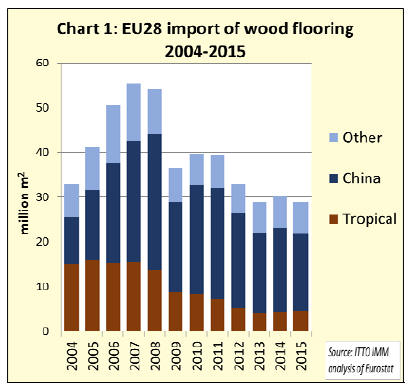
Wood flooring deliveries from China, by far the EU¡¯s
largest single external supplier, fell 7.4% to 17.50 million
m2 in 2015, the lowest level since 2005. While China¡¯s
exports to the UK increased by 2% to 5.19 million m2,
there was a significant decrease in China¡¯s exports to
Belgium (-4% to 2.90 million m2), Netherlands (-8% to
2.07 million m2), Italy (-21% to 1.96 million m2),
Germany (-10% to 1.75 million m2), and France (-47% to
0.44 million m2).
Overall the signs are that Chinese flooring became less
competitive in the EU market in 2015. This is probably
due to a combination of factors notably the weakness of
the euro and concerted efforts by domestic and other
overseas manufacturers in South East Asia and Brazil to
regain share of the European market.
Tightening enforcement of the EU Timber Regulation,
combined with publicity surrounding the Lumber
Liquidators prosecution under the U.S. Lacey Act in
relation to wood flooring from China may also have
discouraged sourcing of Chinese product in 2015.
EU wood flooring imports from tropical countries rise
3%
In contrast to EU imports from China, imports from
tropical countries increased 3% to 4.46 million m2 in
2015. Indonesia remains the single largest tropical supplier
of wood flooring to the EU. Although still low by
historical standards, EU imports from Indonesia increased
4% to 1.59 million m2 in 2015.
There was also a partial rebound in imports from Brazil
(+21% to 0.81 million m2) and continued slow growth in
imports from Vietnam (+9% to 0.33 million m2). However
imports from Malaysia declined 5% to 1.27 million m2
(Chart 2).
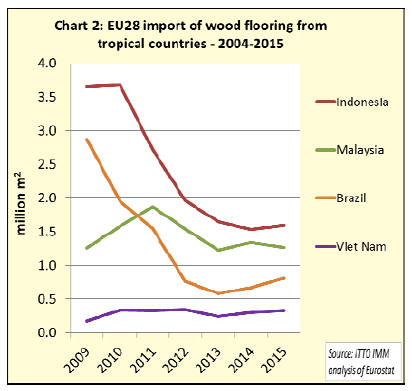
A notable trend in 2015 was a significant switch in
flooring imports by France away from China in favour of
Brazil and Indonesia. However France¡¯s increased imports
from tropical countries was mirrored by a decline in
imports into Belgium suggesting it might be partly due to
changing distribution networks in continental Europe
(Chart 3).
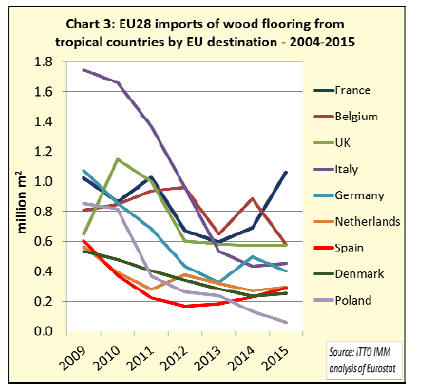
UK imports of wood flooring from tropical countries were
flat during 2015, a rise from Indonesia and Malaysia being
offset by a decline from Hong Kong and Vietnam. This
may be explained by the more advanced state of legality
verification systems in the former two countries as EUTR
enforcement has been tightening in the UK.
Imports of wood flooring from tropical countries into
Italy, formerly the largest EU market for this commodity,
remained flat at a low level in 2015. Imports into Germany
declined in 2015 after a brief recovery in 2015. German
imports from Vietnam were particularly weak last year.
However Sweden and Italy imported more from Vietnam
in 2015.
There was strong variation in EU imports from nontropical
countries in 2015 (Chart 4). Imports from
Switzerland plummeted 40% to 1.1 million m2, probably
due to the strong Swiss franc and related price increases
for Swiss flooring in the Eurozone. Imports from Norway
also dropped by 54% and those from Russia fell by 41%.
However EU wood flooring imports from Ukraine
increased 28% to 3.1 million m2 which may be partly due
to a new law that entered into force in Ukraine in
November 2015 which added oak to the list of ¡°rare and
valuable¡± timber species for which controls are imposed
on a wider range of secondary and tertiary processed
products.
This may have encouraged importers to purchase
additional supplies of oak flooring before November 2015
to beat the extra controls now in place.
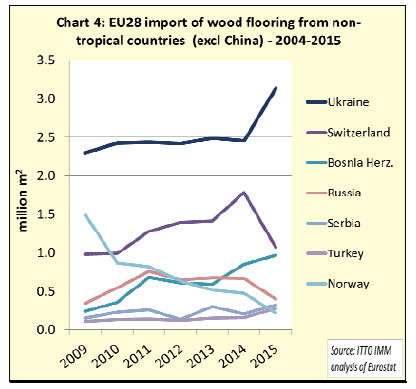
EU wood flooring imports from Bosnia-Herzegovina also
increased sharply in 2015, by 13.5% to 1 million m2.
Bosnia is attracting more investment in wood processing
industries attracted by the countries close proximity to the
EU market, relatively low labour costs for the European
region, and proximity to forest resources which cover 55%
of the country¡¯s land area.
Laminates dominate European flooring market
While the market for real wood flooring recovered some
lost ground in 2015, data published by the European
Producers of Laminate Flooring (EPLF) association
highlight the scale of the challenge from laminate flooring.
Members of the EPLF association sold 452 million m2 of
laminate flooring last year, around 333 million m2 of
which was in Europe, over four times the volume of real
wood flooring consumption in the region.
Overall world-wide sales of EPLF members declined 3%
in 2015. However the decline was almost all in Turkey due
to one Turkish company leaving EPLF and anti-dumping
proceedings by the Turkish Ministry of Economy against
several German flooring manufacturers which ran until the
summer of 2015 (Table 1).
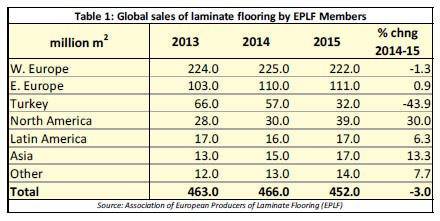
A slight decline in laminate flooring sales in Western
Europe was offset by a rise in Eastern Europe in 2015.
European flooring manufacturers were also increasing
sales in North and South America and Asia last year. This
is due both to the weak euro and an export market
development strategy centred on higher-end quality
products and adherence to European technical and
environmental standards.
The single biggest market for laminate flooring sold by
EPLF members is Germany, which alone accounted for 66
million m2 in 2015, a fall of 4.3% compared to 2014
(Chart 4). Like solid wood flooring, laminate flooring is
also under pressure in Germany from substitute products,
especially LVL.
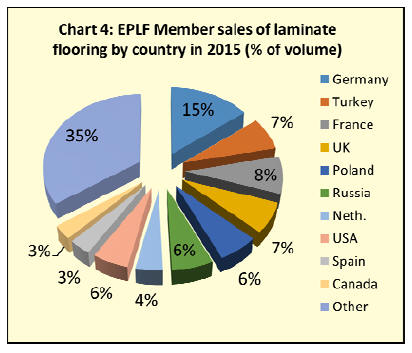
Laminate flooring sales in France, the second largest
market, declined 5.1% to 37 million sq.m in 2015.
The positive trend in the UK recorded in 2014 also ended
last year, with sales falling 3.1% to 31 million sq.m
despite continuing growth in the construction market.
In contrast, recovery in the Netherlands and Spain is
reflected in laminate flooring sales figures. Sales in the
Netherlands increased 11.8% to 19 million sq.m and sales
in Spain were up 4.8% at 15.3 million sq.m.
EPLF member sales in Russia, the largest Eastern
European market for laminate flooring, increased 2% to 29
million m2 in 2015, despite economic difficulties. Sales in
Poland increased 7% to 28 million sq.m and Bulgarian
sales jumped 25% to 5 million sq.m during the year.
Romania and Hungary were stable compared to 2014,
accounting for sales of 11 million sq.m and 6 million sq.m
respectively in 2015. However sales to Ukraine fell 38%
to 5 million sq.m last year.
Germany accused of restricting trade in construction
products
According to EPLF, the German Institute for Building
Technology (DIBt) is considering introduction of special
rules for building products that go well beyond the CE
mark requirements for compliance with the European
Construction Products Regulation and which would
effectively ¡°seal off the German construction products
market from the EU single market¡±.
According to the EPLF, the approach now being
considered may be in breach of a decision taken by the
European Court of Justice in October 2014. This
concluded that Germany¡¯s national requirements for
building products created unnecessary barriers to free
trade in the European free market and must be phased out.
At the time of the Court¡¯s decision ¡°the only building
products that could be used in Germany were those
bearing an Ü mark complying with the DIBt¡¯s own
specifications, which were independent from European
harmonisation¡±, according to EPLF.
Following the decision, DIBt has adopted a new approach
to quality control which would evaluate whole buildings
rather than individual construction products. A draft
document to this effect was circulated among affected
institutions and associations at the end of 2015 and
comments were invited until 25 February 2016.
According to EPLF, which is very critical of this
approach, the draft contains exhaustive requirements
regarding components, emissions, and measurement
procedures. These requirements include a mix of DIBt¡¯s
own stipulations for substances and the EU¡¯s minimum
emission requirements.
The draft has led to protests from industry both in Berlin
and in Brussels. EPLF quotes lawyer Michael
Halstenberg: ¡°in my view, the draft is once again
incompatible with European law. The DIBt doesn¡¯t
understand that setting building product requirements
through an indirect road (through redefining them as
¡°building requirements¡±) isn¡¯t permitted either¡±.
EPLF believes that small and medium-sized companies
would particularly struggle to tender for public
construction projects in Germany in the future.
¡¡
However, the association concedes that other EU
countries, such as France, Belgium, and Sweden, among
others, have adopted a similar approach.
The draft has also been criticised by the German
Multilayer Modular Flooring Association (MMFA) and
the Association of the German Wood-based Panel Industry
(VHI). The full EPLF press release can be found at:
http://bit.ly/26wnH5k .
German timber companies launch campaign against
FSC
A group of 25 German forestry and timber companies
headed by Eurobinia have published a letter calling for
abolition of FSC certification in public forests and asking
that FSC be dropped as a requirement in German public
procurement policy.
According to a report by the Global Timber Forum (GTF),
the letter was sent through a lawyer and addressed to
¡°responsible politicians¡±. A press release was also
distributed to timber industry media.
According to the GTF, FSC Germany responded that the
criticism was too far-fetched for the organisation to
comment officially. The website also quotes German
public procurement and certification specialist Ulrich Bick
from Th¨¹nen-Institute as saying that he saw no reason to
change public procurement requirements ¨C which
currently require that timber be either FSC or PEFC
certified.
Ulrich Bick also suggested there is a broad consensus
between German ministries to maintain the current system.
The full article and a related forum discussion can be found at
http://bit.ly/1Uc5mFM and http://bit.ly/21ccmDC.
|